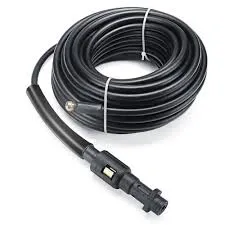power steering wheel hose
Understanding Power Steering Wheel Hose Importance, Function, and Maintenance
Power steering has become an integral part of modern vehicles, providing drivers with enhanced control and ease of maneuverability. At the heart of this sophisticated system lies the power steering wheel hose, a crucial component that ensures the smooth operation of power steering mechanisms. In this article, we will discuss the significance, function, and maintenance of the power steering wheel hose to better understand its role in vehicle performance.
What is a Power Steering Wheel Hose?
The power steering wheel hose is a flexible tube that connects the power steering pump to the steering gear. Its primary function is to transport hydraulic fluid under pressure from the pump to the steering gear, enabling the driver to turn the steering wheel with minimal effort. These hoses are typically made from high-quality rubber or synthetic materials to withstand high pressures and varying temperatures, ensuring longevity and performance.
Importance of the Power Steering Wheel Hose
The power steering wheel hose plays a pivotal role in the overall efficiency of the power steering system. Without a properly functioning hose, the hydraulic fluid cannot flow effectively, leading to increased effort when turning the wheel. This can result in a hard steering experience, making it difficult to control the vehicle, especially at low speeds or while parking.
Furthermore, a damaged power steering hose can lead to fluid leaks, severely compromising the power steering system's functionality. Low fluid levels can not only affect steering performance but can also cause damage to the power steering pump and other related components. Therefore, maintaining the integrity of the power steering wheel hose is essential for safe and enjoyable driving.
Common Issues with Power Steering Wheel Hoses
Despite their robust construction, power steering wheel hoses can experience wear and tear over time
. Some common issues include1. Leaking One of the most frequent problems is the development of leaks due to cracks, abrasions, or weak spots in the hose. This can cause a noticeable drop in hydraulic fluid levels.
power steering wheel hose

2. Bulging or Swelling Excessive pressure or heat can cause the hose to bulge, which may eventually lead to rupture if not addressed promptly.
3. Fraying or Cracking Exposure to environmental elements such as heat, oil, and road debris can lead to fraying or crack formation, impacting the hose's structural integrity.
Maintenance Tips for Power Steering Wheel Hoses
Regular maintenance of the power steering wheel hose can significantly extend its life and ensure optimal performance. Here are some essential maintenance tips
1. Regular Inspections Periodically check the power steering hose for signs of damage, such as cracks, abrasions, or leaks. Early detection can prevent more significant issues down the line.
2. Fluid Level Checks Monitor the power steering fluid level in the reservoir. If levels are consistently low, it may indicate a leak in the hose or other components.
3. Condition of Connectors Inspect the connectors at both ends of the hose for signs of corrosion or wear. Ensuring these connections are tight and secure helps maintain the system’s efficiency.
4. Professional Replacement If you notice any damage or performance issues, consult a professional mechanic for advice. Replacing a damaged power steering wheel hose promptly can save you from more expensive repairs in the future.
Conclusion
The power steering wheel hose is a vital component of your vehicle's steering system, ensuring smooth and efficient handling. Understanding its function and recognizing the signs of wear can help you maintain your vehicle in top condition. By performing regular inspections and addressing any issues promptly, you can enjoy safer and more comfortable driving experiences, knowing that your power steering system is functioning optimally.
-
Ultimate Spiral Protection for Hoses & CablesNewsJun.26,2025
-
The Ultimate Quick-Connect Solutions for Every NeedNewsJun.26,2025
-
SAE J1401 Brake Hose: Reliable Choice for Safe BrakingNewsJun.26,2025
-
Reliable J2064 A/C Hoses for Real-World Cooling NeedsNewsJun.26,2025
-
Heavy-Duty Sewer Jetting Hoses Built to LastNewsJun.26,2025
-
Fix Power Steering Tube Leaks Fast – Durable & Affordable SolutionNewsJun.26,2025

